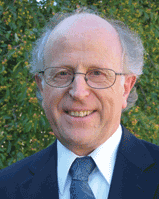
Dear Friends,
On June 1st, Prof. Doug Cooper retired from the faculty of Chemical & Biomolecular Engineering. I couldn't let this occasion go unremarked upon. I’ve been fortunate to have known Doug for about 18 years now. Indeed, he was the Chair of the Search Committee that hired me. Many of you may not be aware of the numerous contributions that Doug has made to the Department, the School, and the University as a whole.
Doug joined UConn in 1985 as a freshly minted PhD from the University of Colorado and has been here ever since. Doug’s technical expertise is in the area of process control. Unlike many of his academic peers, Doug had a strong focus on industry and practical applications from the beginning. He did extensive consulting for the automotive industry in his early years and a tremendous fraction of his research funding was from industry. Doug’s interests led him down an entrepreneurial path, and he founded Control Station, Inc. Beginning as a small startup in the early 2000’s, the company weathered the recession of 2008, and today their software is used by over a third of all the Industrial Fortune 500 Companies.
Even with is his entrepreneurial leanings, Doug was a professor through and through. He translated his practical knowledge to the classroom. Doug started doing on-line teaching in the early 2000’s, long before MOOC’s were popular and before the technology and infrastructure were available. Doug instead built his own infrastructure. He started a blog which included various modules and is now an extensive resource on process control. He wrote a textbook, which he has made freely available on-line. He worked with the UConn Co-Gen plant to make it a living lab for the undergrads and to help use it as a pilot-scale test bed for his research ideas on optimization and process control. He also helped teach our students about the “softer” skills, running an annual workshop for the UConn Chapter of AIChE. He would critique resumés and work through mock interviews with students. He would teach what was appropriate to ask, what not to ask, and how to speak, dress, etc. Outside of the workshop, if any student wanted their resumé reviewed, Doug would do it.
In addition to the research and teaching, Doug’s desire to elevate UConn led him to a number of administrative roles. He served as Department Head twice. The first time was from 2004 to 2006 and the second time was from 2013 to 2016. In addition, as a testimony to his passion for education, Doug served as Vice Provost for Undergraduate Education & Regional Campuses from 2009 to 2011. Finally, I would point out that Doug was also Director of Engineering Computing Services, a service I don’t believe many in the Department are aware of.
Doug’s strong efforts have been recognized via numerous accolades. He has been the recipient of the Faculty of the Year Award as selected by the graduating class multiple times. He was also selected as a University of Connecticut Teaching Fellow in 2003 and was a recipient of the extremely prestigious and competitive US Professor of the Year Award as recognized by the Carnegie Foundation in 2004. Doug is a Fellow of the American Institute of Chemical Engineers and a member of the Connecticut Academy of Science and Engineering.
Personally, I’ve found it to be a privilege and an honor to know Doug. He helped smooth my transition here to UConn as a new faculty member when I was still learning the ropes. Throughout the entire time I’ve known Doug, one thing has become abundantly clear to me. Doug loves this Department. Everything he has done has always been in pursuit of making the Department a better place for students, staff, and faculty. Whenever I’ve spoken to Doug, his focus has always been on how we can remove impediments faced by faculty to make them as successful as possible; what are practical effective methods to teach students and what are the topics that they will really use after graduation; and what can we do to ease the ever increasing burden on our staff.
We have all been very fortunate to know Doug, and the Department is a better place for him being here. Thanks Doug for all the has done for us.
Ranjan Srivastava
Prof. & Dept. Head








